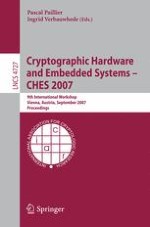CHES2007,theninthworkshoponCryptographicHardwareandEmbeddedS- tems, was sponsored by the International Association for Cryptologic Research (IACR) and held in Vienna, Austria, September 10–13, 2007. The workshop - ceived 99 submissions from 24 countries, of which the Program Committee (39 members from 15 countries) selected 31 for presentation. For the ?rst time in the history of CHES, each submission was reviewed by at least four reviewers instead of three (and at least ?ve for submissions by PC members, those now being limited to two per member) and many submitted papers have received plenty of extra reviews (some papers received up to nine reviews), thus totalling the unprecedented record of 483 reviews overall. Thepaperscollectedinthisvolumerepresentcutting-edgeworldwideresearch in the rapidly evolving ?elds of crypto-hardware, fault-based and side-channel cryptanalysis, and embedded cryptography, at the crossing of academic and - dustrial research. The wide diversity of subjects appearing in these proceedings covers virtually all related areas and shows our e?orts to extend the scope of CHES more than usual. Although a relatively young workshop, CHES is now ?rmlyestablishedasascienti?ceventofreferenceappreciatedbymoreandmore renowned experts of theory and practice: many high-quality works were subm- ted, all of which, sadly, could not be accepted. Selecting from so many good worksis no easy task and our deepest thanks go to the members of the Program Committee for their involvement, excellence, and team spirit. We are grateful to the numerous external reviewers listed below for their expertise and assistance in our deliberations.
